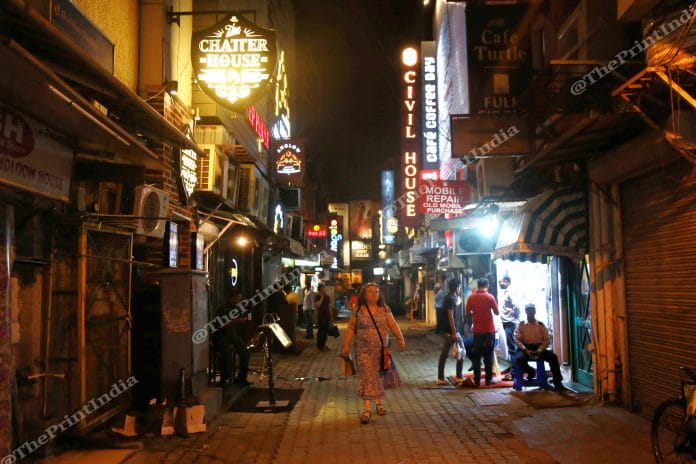New Delhi: Prime Minister-elect Narendra Modi’s dig at the “Khan Market Gang” during the Lok Sabha election campaign and BJP general secretary Ram Madhav’s reference to it in a column has put the scanner firmly on the upscale complex in Lutyens’ Delhi. But no one seems to be looking at the underbelly of Khan Market — that the Delhi Fire Service and the New Delhi Municipal Council (NDMC) believe it is a fire hazard.
Khan Market is home to some of the capital’s most posh restaurants, but their narrow staircases and constricted space compounds the fact that they lack basic fire safety measures such as access roads for fire engines and mandatory alternate exits.
The issue becomes all the more critical in light of the Surat fire tragedy last week that claimed the lives of 22 students in Gujarat.
Seating capacity loophole
It was only in 2003 that commercial restaurants were given licences to operate in Khan Market. According to the NDMC, two years later, Side Wok became the first restaurant to get a licence. Since then, 36 eateries and pubs have opened up.
Restaurant licences are sanctioned by the NDMC. After a health and infrastructure assessment, the NDMC decides whether the restaurants need a No Objection Certificate (NOC) from the Delhi Fire Service. But only restaurants with a seating capacity of over 50 are required to apply for such a licence, so only three restaurants — Town Hall, Big Chill and Out of the Box — have obtained NOCs from the fire department.
The other restaurants all have a seating capacity below 50, often ranging between 46-48, according to Dinesh Bali, spokesperson for the Khan Market Traders’ Association.
However, a senior NDMC official, who did not wish to be identified, disputed this claim, saying the restaurants claim a sub-50 number to escape complying with fire norms.
“We can’t conduct too many checks since the restaurant owners often begin to allege blackmail or harassment,” the official said.
“Often, what happens is when we go to conduct a check, word gets around and those violating the norms just hide whatever extra seats they have on the terrace to avoid sealing.”
Also read: Sushi stop for Gandhis, jewel jaunt for Smriti Irani: Khan Market truly a Lutyens’ darling
‘Patronised by power’
Government officials complain that since Khan Market is “patronised by power”, there isn’t much they can do about it.
“We aren’t allowed to permanently seal properties, so at most, we ask for compliance after issuing a show-cause notice,” another senior NDMC official said. “If they meet our conditions, we reopen the properties.”
A senior Delhi Fire Service official added that most of the establishments are owned by “higher-ups”, so they get away with such violations.
“There’s always political pressure, it’s not like we have much choice,” the fire official said. “Khan Market is a high-risk structure. The buildings are old and, of course, there’s the issue of parking. For successful rescue operations to happen, our fire engines need space to enter the market. There is none. Neither are there proper exits.”
Courts’ concern
In 2016, the Delhi High Court had termed Khan Market a “disaster waiting to happen”. The court had ordered all restaurants, irrespective of seating capacity, to implement fire safety norms, and had asked the NDMC to reconsider its policy, but that never happened as agencies cited a “lack of clarity”.
The Supreme Court in 2018 also flagged the violations in Khan Market and asked the concerned authorities to act on them immediately. A three-judge bench had said that by not enforcing fire norms, the authorities were “playing with the lives of citizens”.
However, now, the fire official said, “things are changing”.
“Ever since the fire at Arpit Hotel in Karol Bagh, we are even asked to look at restaurants with a seating capacity of less than 50,” the official said.
Traders’ stand
Bali, meanwhile, said the law is rigged against the traders.
“Restaurants are not supposed to apply for a licence if the seating capacity is below 50. Then why should they?” he asked.
He also blamed the transition of the area from a residential to a commercial complex in a “haphazard” manner for its present state.
“No application of mind was used when the rules were formulated. We can’t even make structural changes to the properties, how can restaurants functions in bedrooms?” he asked.
Also read: Blocked fire exits & bust alarms — India’s Parliament is a fire hazard







We need to address this ASAP before a fire comes n burns the place down…n please stop changing names…how pathetic is that
Thanks for awareness